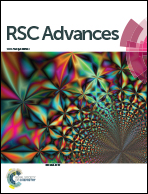Facile synthesis of dual-emission fluorescent carbon nanodots for a multifunctional probe†
Abstract
In this study, we developed a facile method for synthesizing dual-emission carbon nanodots (CDs) through trimesic acid and o-phenylenediamine through electrolysis for 2 h. The synthesized CDs were mainly 3–7 nm in size, with an average size of 5.17 nm. The dual-emission fluorescent property of these CDs could be observed under two different excitation wavelengths. The green emission of the CDs could be quenched after the addition of mercury ions or copper ions, and the blue emission of the CDs could be inhibited using hydroxychloroquine (HCQ). Furthermore, the quenched fluorescence of CDs/Cu2+ could be recovered through the addition of glyphosate. We developed a multifunctional chemical sensor by using these special fluorescence materials. Under optimal conditions, the detection limits of mercury ions, glyphosate, and HCQ were 0.42 μM, 1.1 mg L−1, and 0.14 μM, respectively. Moreover, this method can be used to detect mercury ions, glyphosate, and HCQ in environmental water, cereals, and urine samples, respectively.



 Please wait while we load your content...
Please wait while we load your content...